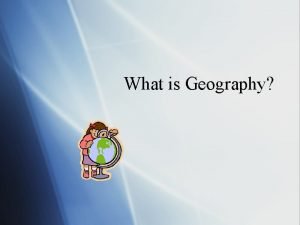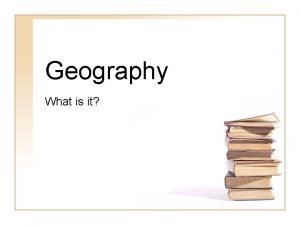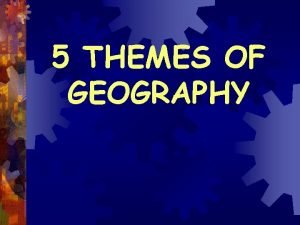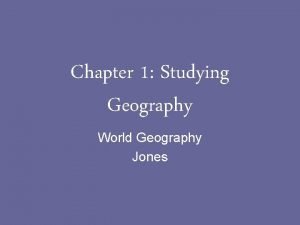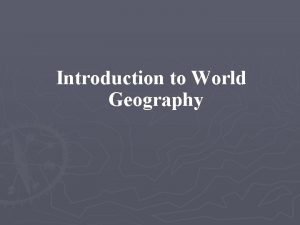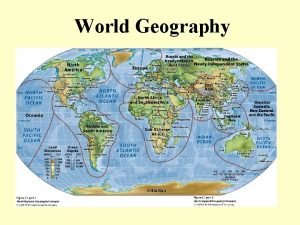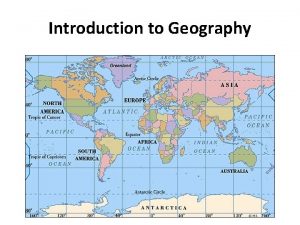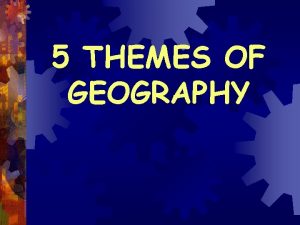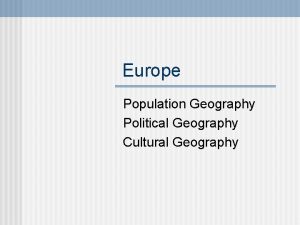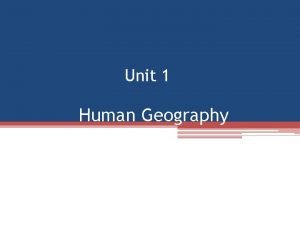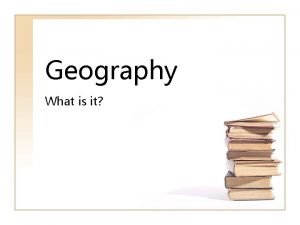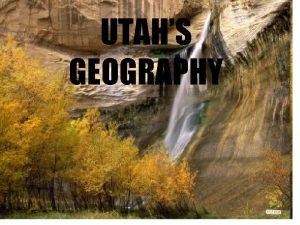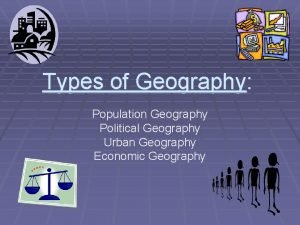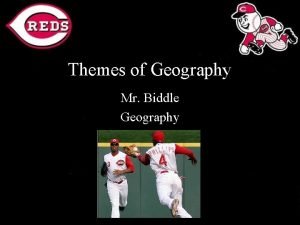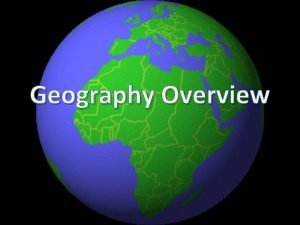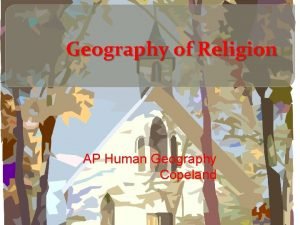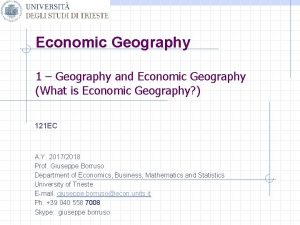What is geography Geography n Geography is the




























- Slides: 28

What is geography?

Geography n Geography is the study of human and nonhuman features of Earth

n n Geography is the study of earth. • Geographers ask: 1. Where is it? 2. Why is it there?

Latitude It is measured in degrees Latitude: is the distance north and south of the Equator Degrees: units that measure angles

The Equator: a line drawn halfway between the North and South Poles

Longitude

Prime Meridian Lines of longitude are also called meridians

The Five Themes of Geography n n 1. 2. 3. 4. 5. Help to understand the world. Key areas to learn about when studying a place or concept. Location Place Region Movement Human/ Environment Interaction

n Location asks: Where is it located? ▪ It tells us where a point is on the Earth’s surface.

Location n An absolute location can be a latitude and longitude point or a street address. The address where you live: Latitude: 55° North 555 Main Street Longitude: 9° West

Location n A relative location is given in relation to borders, landmarks, distance, or direction.

Let’s Practice- Relative or Absolute n Bartlett, TN is 21 miles Northeast of Olive Branch, MS. n I live at 321 Main Street. n My house is a mile away from Kroger.

Your turn!

Place n Place asks: What does it look like? ▪These may include climate, people, and landforms.

Place The sunny islands of Hawaii have beaches, tourists, and military bases.

PLACE n n n It is a description of what makes that place different from others. PLACE is divided into 2 parts: Physical Differences and Human Differences Physical differences, or characteristics, include things that occur naturally, such as mountains, rivers, type of soil, wildlife, climate etc. Human differences, or characteristics, are things that have changed due to people, such as roads and buildings, how people live and their traditions. This is where you can really go to town in your description. You can discuss the cities, lifestyle, culture and all sorts of other interesting facts that make the place you are talking about different and special.

PLACE ~more~ n What physical characteristics exist in this city such as plant and animal life? What cultural (human) characteristics are typical of this city? Which ethnic, religious, or political groups live here? * Answer the questions about Place on your graphic organizer before you move on

Regions n Regions ask: How and why is one place similar to another? Areas of the earth that are alike in some way.

Regions Places united by common characteristics.

Southwest Region The southwest region of the U. S. is know to have a hot and dry climate and share a border with Mexico to the south.

REGION n n n The four types of areas are: government/physical, human, cultural, or functional Regions defined by a government or physical characteristics are regions that are strictly maintained, such as countries , continents, or physical regions (e. g. Appalachian Mountain Region) Regions defined by a function areas served by a particular service. Take the example of a fictitious school district of Geek's Rule School. Example: Center Hill District Another examples would be areas which provide certain functions, like a telephone area code, zip code, or even a bus service area. Loosely defined regions are regions that are grouped together in general terms. These are things such as the North, or the Mid-West, or the Bible belt, or even the Far East and Middle East. Cultural regions are regions which a region having a distinct pattern of culture. Like the Great Plains Indians region, Latin America (language), or Muslim region (religion)

n Movement asks: How and why are places connected with one another? We travel and communicate with one another. We depend on each other for products and ideas.

Movement Internet n Travel How people share ideas, people, and goods to shape the world.

MOVEMENT Things to think about n Movement -- What are the patterns of movement of people, products, and information? A study of movement includes learning about major modes of transportation used by people, an area's major exports and imports, and ways in which people communicate (move ideas).

Human-Environment Interaction asks: What is the relationship between humans and their environment? How people react to and change the environment.

Human-Environment Interaction n People getting along with nature

HUMAN-ENVIRONMENT INTERACTIONS Human-Environment Interactions can be divided into 3 parts: How people have been changed by the environment, how the environment has been changed by people, and how people depend on the environment. n How people have been changed by the environment can be called adaptation. It is the way humans change to suit their environment. An example of this is people who live in very cold climates wearing wellinsulated clothes to keep warm, or in a warm climate wearing shorts and a tank top to stay cool. n How the environment has been changed or modification is the way people change their environment to suit themselves. Artificially watering your lawn if you live in a dry area is one example. Another good example is clearing forests to make room for growing crops. Even building a bridge is an example of changing or modifying your environment. n Depending on the environment is when people depend on their environment for something. Examples of this are using trees for firewood, or coal to warm us in winter, rivers to transport goods to sell or exchange for other needed items that are not available, rivers also provide us with drinking water. n

Journaling Why are the five themes important when studying a new place? n
 Voi kéo gỗ như thế nào
Voi kéo gỗ như thế nào Thiếu nhi thế giới liên hoan
Thiếu nhi thế giới liên hoan Phối cảnh
Phối cảnh Một số thể thơ truyền thống
Một số thể thơ truyền thống Thế nào là hệ số cao nhất
Thế nào là hệ số cao nhất Hệ hô hấp
Hệ hô hấp Slidetodoc
Slidetodoc Số nguyên tố là số gì
Số nguyên tố là số gì Tư thế ngồi viết
Tư thế ngồi viết đặc điểm cơ thể của người tối cổ
đặc điểm cơ thể của người tối cổ Mật thư anh em như thể tay chân
Mật thư anh em như thể tay chân Các châu lục và đại dương trên thế giới
Các châu lục và đại dương trên thế giới Thang điểm glasgow
Thang điểm glasgow ưu thế lai là gì
ưu thế lai là gì Thẻ vin
Thẻ vin Cái miệng bé xinh thế chỉ nói điều hay thôi
Cái miệng bé xinh thế chỉ nói điều hay thôi Các châu lục và đại dương trên thế giới
Các châu lục và đại dương trên thế giới Bổ thể
Bổ thể Từ ngữ thể hiện lòng nhân hậu
Từ ngữ thể hiện lòng nhân hậu Tư thế ngồi viết
Tư thế ngồi viết V cc cc
V cc cc Làm thế nào để 102-1=99
Làm thế nào để 102-1=99 Thể thơ truyền thống
Thể thơ truyền thống Chúa sống lại
Chúa sống lại Khi nào hổ mẹ dạy hổ con săn mồi
Khi nào hổ mẹ dạy hổ con săn mồi đại từ thay thế
đại từ thay thế Diễn thế sinh thái là
Diễn thế sinh thái là Vẽ hình chiếu vuông góc của vật thể sau
Vẽ hình chiếu vuông góc của vật thể sau Công thức tiính động năng
Công thức tiính động năng





























